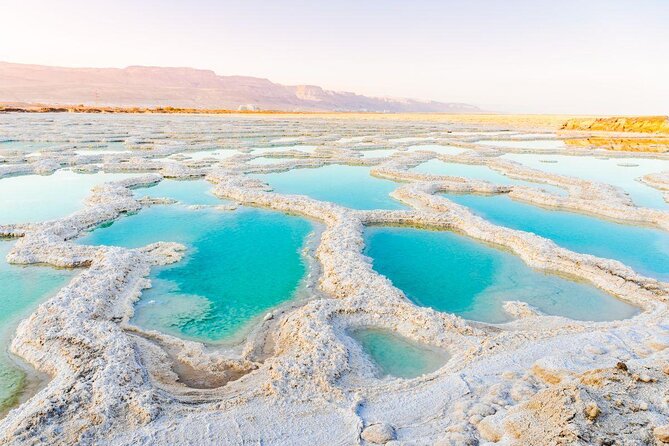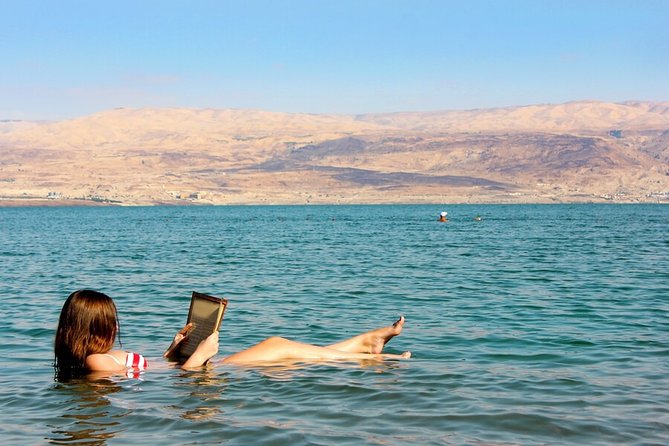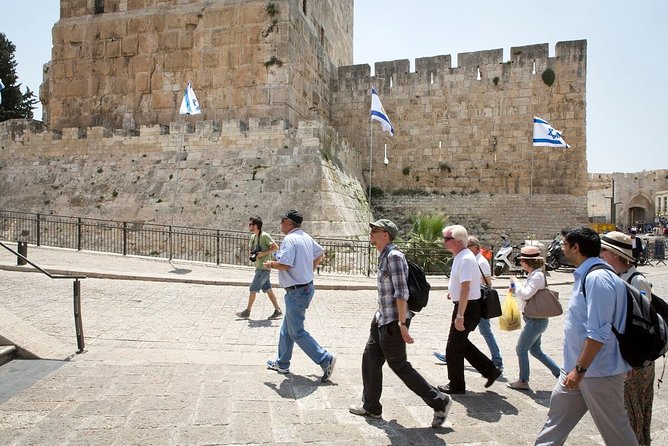Exploring the ancient and sacred sites of Jerusalem and the restorative waters of the Dead Sea offers visitors a truly unique and enriching experience. From the awe-inspiring Western Wall to the reflective journey along the Via Dolorosa, the Old City immerses travelers in deep-rooted religious traditions. Contrasting this spiritual atmosphere, the therapeutic benefits of floating in the mineral-rich waters of the Dead Sea provide a serene respite. Tying this remarkable region together, the historic city of Jericho adds further depth to this captivating journey. What secrets and enlightenment await those who venture to this extraordinary part of the world?
Key Points

- Explore the historic Old City of Jerusalem, including the Western Wall and the Via Dolorosa, to experience the city’s rich religious heritage.
- Visit the Dead Sea, where visitors can float effortlessly in the mineral-rich waters and indulge in the therapeutic mud along the shore.
- Enjoy the serene and rejuvenating experience of the Dead Sea, taking in the panoramic desert landscapes and the unique sensation of floating on the water.
- Discover the ancient city of Jericho, one of the oldest continuously inhabited cities in the world, and visit the Mount of Temptation and the Jordan River.
- The day trip from Tel Aviv to Jerusalem and the Dead Sea provides a diverse and immersive experience, combining historical, religious, and natural wonders.
Exploring the Old City of Jerusalem

Starting in the Old City of Jerusalem, visitors will first see the iconic Western Wall, also known as the Wailing Wall, which is one of the most sacred sites in Judaism.
This ancient limestone retaining wall was built as part of the expansion of the Second Temple. Today, it’s a place of prayer and pilgrimage, where worshippers come to leave handwritten notes in the cracks between the stones.
From there, visitors can walk the Via Dolorosa, the route believed to be the path Jesus took on his way to crucifixion. Along this historic path, they’ll see several Stations of the Cross, which commemorate key events during Jesus’ final journey.
You can also read our reviews of more tours and experiences in Tel Aviv.
The Significance of the Western Wall

The Western Wall, or Wailing Wall, holds immense spiritual significance for the Jewish people as it’s the last remaining structure from the ancient Jewish Temple in Jerusalem.
Visitors come to this sacred site to pray, mourn the destruction of the Temple, and connect with their religious heritage. Many leave written prayers in the wall’s crevices, seeking divine intervention.
The Western Wall’s significance transcends its physical form, as it represents the enduring faith and resilience of the Jewish people. Regardless of one’s religious affiliation, the Western Wall‘s timeless allure captivates all who visit, offering a profound glimpse into the deep-rooted traditions and beliefs that have sustained the Jewish community for millennia.
Walking the Via Dolorosa
Visitors to the Old City of Jerusalem can trace the iconic Via Dolorosa, the route believed to be the path Jesus walked on his way to crucifixion.
This sacred pilgrimage takes one through the winding streets of the Old City, past the 14 Stations of the Cross that mark significant moments along Jesus’ journey. Pilgrims follow in Christ’s footsteps, stopping to reflect and pray at each station.
Along the way, they’ll see ancient churches, shrines, and other holy sites. The Via Dolorosa culminates at the Church of the Holy Sepulchre, the site of Jesus’ crucifixion, burial, and resurrection.
Walking this historic route is a deeply meaningful experience for many visitors to Jerusalem.
Experiencing the Therapeutic Dead Sea

After exploring the historic Old City of Jerusalem, the journey continues to the remarkable Dead Sea, where visitors can experience its unique therapeutic qualities.
Floating effortlessly in the salt-rich waters is a one-of-a-kind sensation, as the high mineral content makes it almost impossible to sink.
The mud along the shoreline is also renowned for its skin-nourishing properties, providing a natural spa-like treatment. Visitors can slather the mineral-rich mud all over their bodies and let it work its magic, before rinsing off in the buoyant waters.
This is a truly rejuvenating and relaxing experience, unlike any other, that completes the day’s exploration of Israel’s most iconic sights.
Floating on the Mineral-Rich Waters
Floating effortlessly on the mineral-rich waters of the Dead Sea is a remarkable experience that captivates visitors. The high salt concentration, nearly 10 times saltier than the ocean, creates a buoyancy that allows one to recline and relax with ease, almost as if the water is cradling the body.
This unique sensation, unlike any other swimming or floating experience, is a highlight of any visit to this iconic natural wonder.
The therapeutic mud along the shore is also a popular activity, as it’s believed to have healing properties for the skin. Visitors can slather on the nutrient-dense mud and let it dry before rinsing off, leaving the skin feeling soft and rejuvenated.
Relaxing on the Dead Sea Beach

Along the shore of the Dead Sea, travelers can readily unwind on the mineral-rich beach, basking in the therapeutic mud and tranquil waters.
The high salt content of the Dead Sea allows visitors to effortlessly float, providing a unique and relaxing experience. After seeing the rejuvenating mud, they can rinse off in the warm, soothing waters.
The peaceful atmosphere and panoramic vistas of the surrounding desert landscapes further contribute to the serene ambiance. With ample time allotted, guests can fully indulge in the restorative properties of this natural wonder, leaving feeling refreshed and invigorated.
The Dead Sea beach offers a delightful respite from the day’s activities, complementing the excursion’s other captivating sights.
Traveling Through the Historical Jericho
On the return journey to Tel Aviv, the tour passes through the historical city of Jericho, offering a glimpse into its storied past. Jericho is one of the oldest continuously inhabited cities in the world, with a history dating back over 10,000 years. As the bus winds its way through the city, passengers can catch glimpses of its ancient ruins and landmarks.
| Landmark | Significance |
|---|---|
| Tel es-Sultan | Believed to be the site of the biblical city of Jericho, destroyed by Joshua |
| Mount of Temptation | Where Jesus Christ was tempted by the devil according to the Bible |
| Qasr el-Yahud | The traditional site of Jesus Christ’s baptism in the Jordan River |
This brief encounter with Jericho provides a fascinating contrast to the otherworldly experience of the Dead Sea.
Tour Inclusions and Exclusions

The tour includes hotel pickup and drop-off, a professional guide, air-conditioned transportation, and entrance fees.
However, it excludes food, drinks, and gratuities, which participants must cover independently.
This ensures that the core components of the experience – exploring Jerusalem’s Old City and floating in the Dead Sea – are provided, while giving travelers the flexibility to choose their own dining options and tip amounts.
Frequently Asked Questions
Can I Bring Food and Drinks on the Tour?
According to the tour details, food and drinks are not included in the tour. Travelers can bring their own snacks and beverages, but there are no provisions for consumption provided during the excursion.
Do I Need to Wear Specific Clothing for the Dead Sea?
For the Dead Sea, it’s recommended to wear lightweight, comfortable clothing that can get wet. Bring water shoes or sandals to protect feet on the pebbly beach. Wearing a swimsuit is also advised to fully experience floating in the mineral-rich waters.
How Much Time Is Allotted for Each Site Visit?
The tour typically allots around 2 hours for the visit to the Dead Sea, allowing time to float in the mineral-rich waters and experience the therapeutic benefits of the mud. The time spent at the Old City of Jerusalem may vary but is usually a significant portion of the day.
Is There an Option to Extend the Tour Duration?
Yes, the tour typically allows around 2 hours at the Dead Sea, but travelers can often extend their stay for an additional fee. This provides more time to enjoy the unique therapeutic benefits of the salt-rich waters.
Can I Purchase Souvenirs at the Tour Stops?
Yes, travelers can typically purchase souvenirs at the tour stops. Many of the holy sites and the Dead Sea area offer a variety of local crafts, jewelry, and other keepsakes for visitors to browse and buy.
Recap
Exploring Jerusalem’s Old City and the therapeutic Dead Sea offers a unique and captivating experience. Visitors can enjoy the city’s rich religious heritage, from the sacred Western Wall to the famous Via Dolorosa.
The rejuvenating waters and mud of the Dead Sea provide a serene contrast, while the ancient city of Jericho further enhances the region’s historical significance.
This journey through Israel’s remarkable landmarks is a must-see for any traveler.
More Tour Reviews in Tel Aviv
Not for you? Here's more things to do in Tel Aviv we have recnetly reviewed
- Full-Day Masada and Dead Sea From Tel Aviv
- Jerusalem Guided Tour From Tel Aviv
- Levinsky Market Tasting Tour
- Hebron Dual Narrative Tour From Tel Aviv
- Jerusalem & Dead Sea Private Tour – Visit Holy Jerusalem & Dead Sea Relaxation
- Tel Aviv to Ben Gurion Airport (TLV) Private Departure Transfers
- Tel Aviv Street Art Tour
- Nazareth and the Sea of Galilee Day Trip From Tel Aviv
- Tel Aviv Airport (TLV) to Jerusalem Hotels – Private Transfer
- Christian Sites by the Sea of Galilee From Tel Aviv
- Dead Sea Relaxation Day From Tel Aviv
- Tel Aviv & Old City of Jaffa – Tiny Group From Tel Aviv
